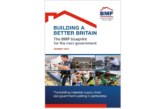
Workloads for small building companies fell in the final quarter of 2019 but builders are more optimistic for 2020 according to a recent survey from the Federation of Master Builders (FMB).
The key results of the FMB’s State of Trade Survey for Q4 are:
- In the three months to December 2019 builders’ workloads fell into negative territory with around 21% of firms reporting lower workloads, 5% higher than the previous quarter;
- Expectations for the future rose with 37% of builders predicting higher workloads over the coming three months;
- Northern Ireland was the only home nation to see an increase in workloads and enquiries;
- Material and wage costs are likely to rise over the coming six months;
- Employment activity moved back into positive territory for the first time since Q1 2019 with just under one in five (19%) builders reporting an increase in staffing levels
Commenting on the results of the survey, Chief Executive of the FMB, Brian Berry, said: “The end of 2019 was a very turbulent period in the UK, both politically and economically, with Brexit gridlock and a General Election. When you consider this, along with the bad weather we saw in October, it is not surprising that the order books of small and medium-sized construction firms took a hit. We know that many consumers were holding off making important spending decisions until the outcome of the General Election was known and this took its toll on workloads”
Berry continued: “Builders are more optimistic for the future, however, with over a third of SMEs predicting higher workloads over the coming three months. We are yet to see if there has been a so called ‘Boris bounce’ yet, following the election result, but there are some positive signs. For example, employment levels amongst SMEs have returned to positive ground for the first time since the start of 2019. This of course, brings with it concerns around skills shortages, and SMEs continue to struggle to hire key trades such as bricklayers and carpenters”
Berry concluded: “With the Budget due in early March, this provides a perfect opportunity to restore some confidence back into the construction industry. Builders will be instrumental in delivering key government objectives such as 300,000 new homes by the mid-2020s and reaching Net Zero carbon emissions by 2050. Radical policies will be needed to deliver these targets which should include reform of the planning system and a new strategy to make our existing homes more energy efficient.”









